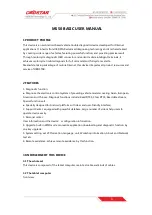
5
line. Keep in mind that you need clear water flow across the face
of the transducers to insure a clear reading at all speeds. Stay
away from rivets, ribs, or strakes that would be just in front of
the transducers. They will disturb the water and scramble the
reading. The 107 kHz transducer is more susceptible to this effect
than the 400 kHz transducer, so it is a good idea to place it closer
to the center of the transom where smooth water flow is easier to
maintain.
After you attach each mounting bracket to each transducer, hold
it up to the boat where you are planning to mount it. Mark the
four holes on the transom, or mounting plate, so that when the
bottom of the transducer is flush with the bottom of the boat the
holes are located at the bottom of the bracket slots. This gives
you room to "fine tune" the position of the transducer downward
and optimize your reading after you've put the boat back in
the water. Drill out the holes and install the transducer bracket
assembly. Tighten the screws down securely. Be sure to seal any
holes drilled into the transom with silicone to prevent water from
leaking into the boat.
Route the transducer cord up to the unit taking the same care as
you did when you routed the power cord. Make sure that the
cord is restrained and not allowed to flop around in the wind.
This can cause stress on the wire inside the cable, and possible
breakage. Plug the transducer connector into the back of the unit
and screw the retaining ring down tight. Make sure the frequency
labeled on the transducer cable matches the frequency labeled on
the transducer jack on the unit. If you get the two transducer con-
nections reversed, the until will not operate properly.
After you have put the boat back in the water confirm that you
can maintain a bottom reading at all boat speeds. If not, loosen
the bracket screws and tilt the transducer some more. Keep the
front edge flush with the boat, but drop the back edge down a
little more. If changing this angle several times does not clear up
the reading, loosen the mounting screws and slide the transducer
down slightly. Repeat these adjustments until you get a clear
reading. You’ll most likely be looking for a balance between high
speed performance and the transducers producing a “rooster
tail”. The further you go down below the hull, the better the
transducer will perform at high speed, but the more likely it will
be to result in water spray. Make sure that all mounting screws
are tight when you’re done adjusting.
Trolling Motor Mounting
Install the transducers into the one-piece trolling motor mount-
ing bracket as shown. Use the two included large cable ties to
attach the transducer to the electric trolling motors lower unit.
Using the slots in the transducer bracket, run the ties through
them and around the motors lower unit. Locate the transducers
on the bottom of the lower unit as shown. Locate the 107 kHz
towards the front of the motor. This transducer is more suscep-
tible to turbulence, so keep it further away from the propeller.
Run the cables up the shaft using
smaller cable ties or electrical
tape to hold it them in position.
Make sure that the cables will
not be damaged by the move-
ment of the trolling motor. Plug
the transducer connectors into
the back of the unit and tighten
the retaining rings. Make sure
the frequency label on the
transducer cable matched the
frequency labeled on the trans-
ducer jack on the unit. If you get
the two transducer connections
reversed, the until will not oper-
ate properly.


































